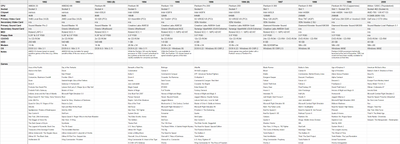Reply 160 of 232, by VivienM
ElectroSoldier wrote on 2023-10-30, 03:26:I would suggest maybe 1% of the people on Vogons use their Windows 98 PCs like we did back in the late 90s into the 2000s. The r […]
kingcake wrote on 2023-10-29, 20:20:VivienM wrote on 2023-10-29, 13:42:I believe one of the reasons that it was kept is that a whole number of Windows 3.1 installers added icons/program groups by directly interacting with progman.exe instead of using the proper APIs (which, in 9x, switched to generating shortcuts/folders in the start menu items). An early example of Microsoft keeping unnecessary dated stuff in the name of compatibility...
No offense, but you have the wildest, most unhinged takes on Windows 98 that I've ever seen. Every post of yours is about how 98 was unusable. I built hundreds of 98 machines for customers during that time (and supported them) and never experienced problems that weren't related to hardware issues like bad ram. Plenty of people on Vogons, including myself, build myriad permutations of Win98 machines and game on them for hours on end without "resource problems" and instability.
Also, your posts about old hardware are broad and incorrect. "Old" CPUs had MMUs. The CPU+MMU combo just didn't support modern features like virtual memory, etc.
I would suggest maybe 1% of the people on Vogons use their Windows 98 PCs like we did back in the late 90s into the 2000s.
The resource problems are baked into the Win9x architecture itself and the underlaying problem is DOS.I have a few PCs running Windows 98 today and the experience is very different to the ones I had back when I owned them in the 90s, and that is purely down to the way we use them now.
Half or all of the software I used to have to install then just isnt needed now so none of the problems will manifest themselves and Windows wont struggle.Its not like this is just my opinion on 98, its based on technical limitations of the OS itself and is well documented.
Yup, and the thing is, what caused the resource problems was multitasking. On my PIII in 2000, I would have had a web browser with a couple windows, two IM clients (ICQ/AIM, actually maybe also MSN Messenger was out by then so make that three), a copy of mIRC or two, an email client, a newsreader (anyone remember Usenet before it got completely destroyed by binaries? 23 years ago we would have had this discussion in comp.sys.ibm-pc.something), Winamp, etc. Plus any productivity application I was actually working with. Win98 SE could not handle that - the system resources would dip and dip and boom, instability, reboot, etc after a few hours or, at most, a few days. Win2000 struggled a bit with the same workload with 128 megs of RAM, but give it 256 megs and it just was happy and didn't need rebooting for weeks/months.
No one would do that on a retro PC today. Or, really, any sort of multitasking. For one thing, the servers are no longer there for most of those Internet apps (even if, say, ICQ is still around, I would be shocked if any version of ICQ compatible with 98SE could connect to today's servers). For another, well, the security issues. But more importantly, the purpose of a retro PC tends to be retro games, and... why do you need a bunch of background apps behind your retro game if you're surrounded by modern machines?
And I think this also comes back to why everybody (particularly non-enthusiasts) loved XP so much. For most people who didn't have 2000, XP was their first experience (no pun intended) of a serious, robust OS. And its long life meant that by 2004-5, you didn't have any driver/device compatibility issues. And the rise of telemetry, frequent patches, etc meant that software generally was getting more reliable.


